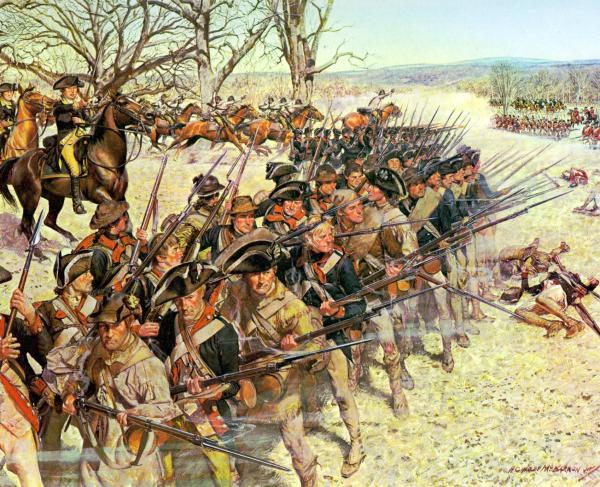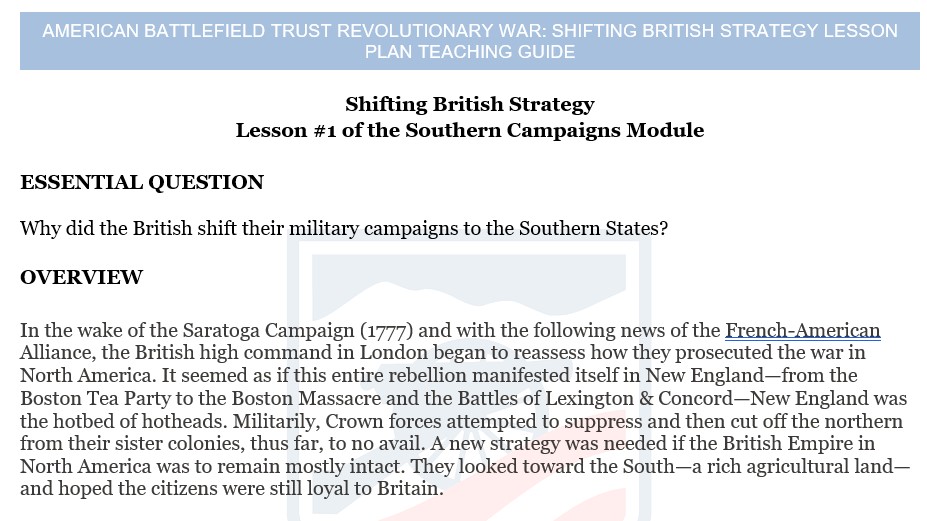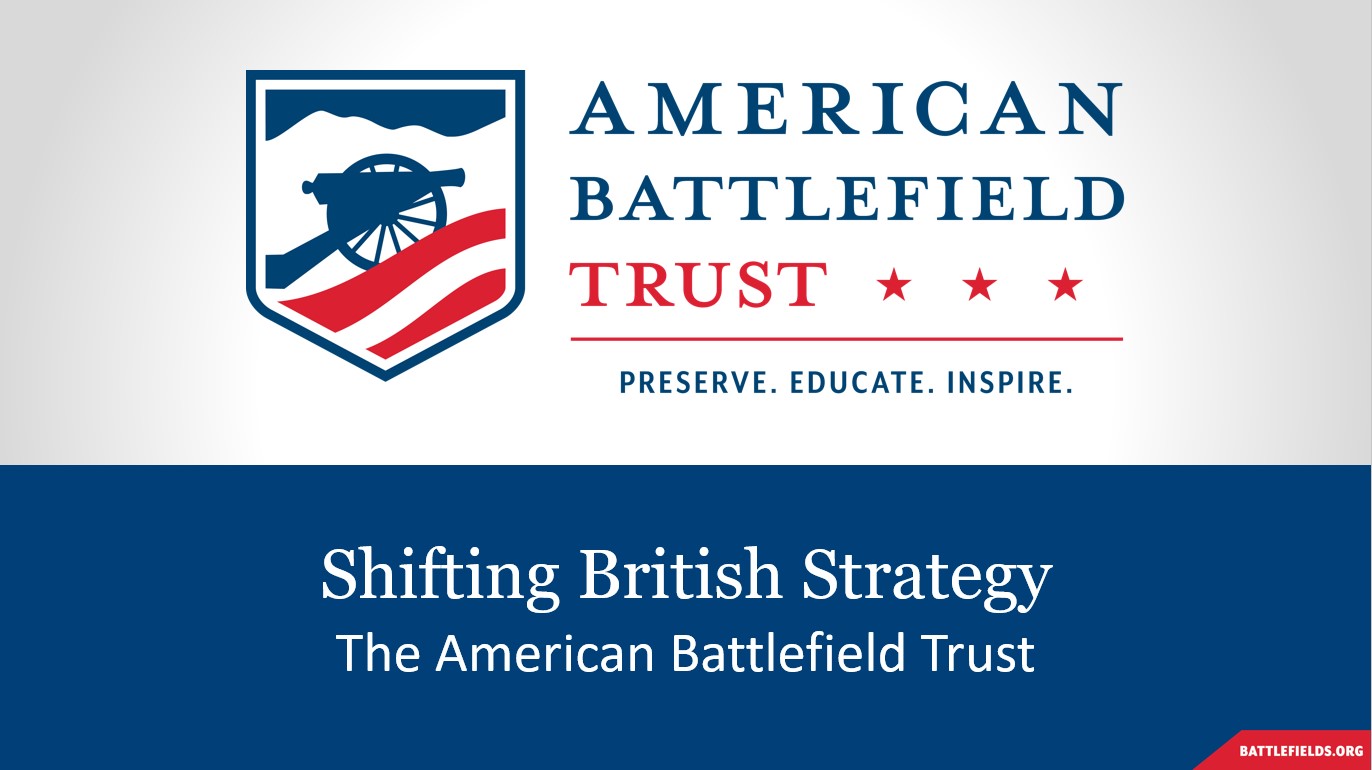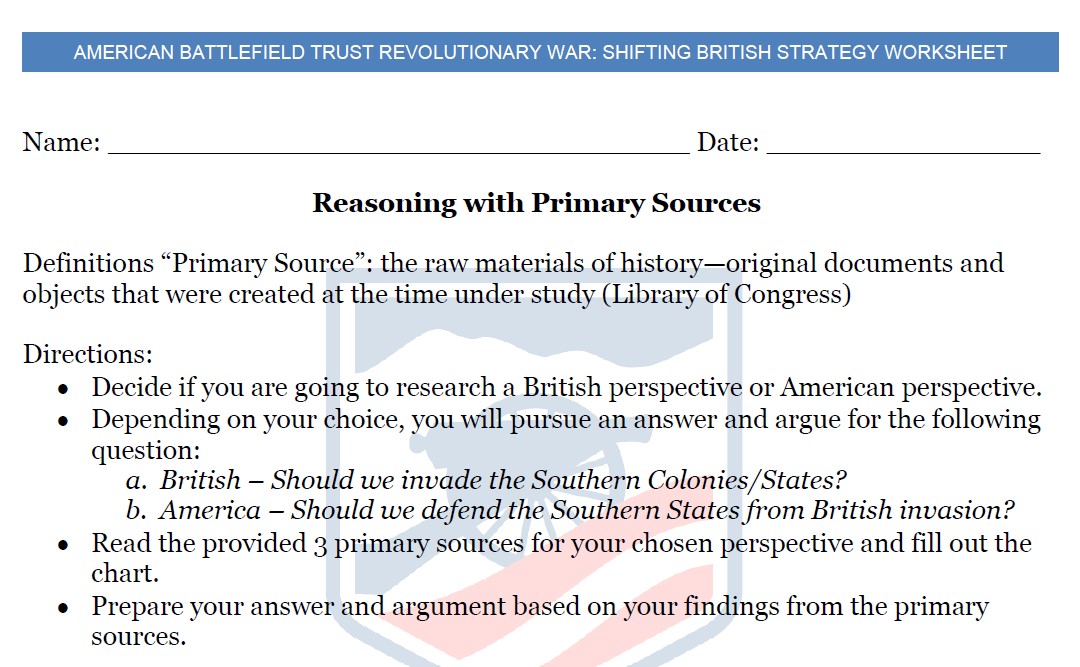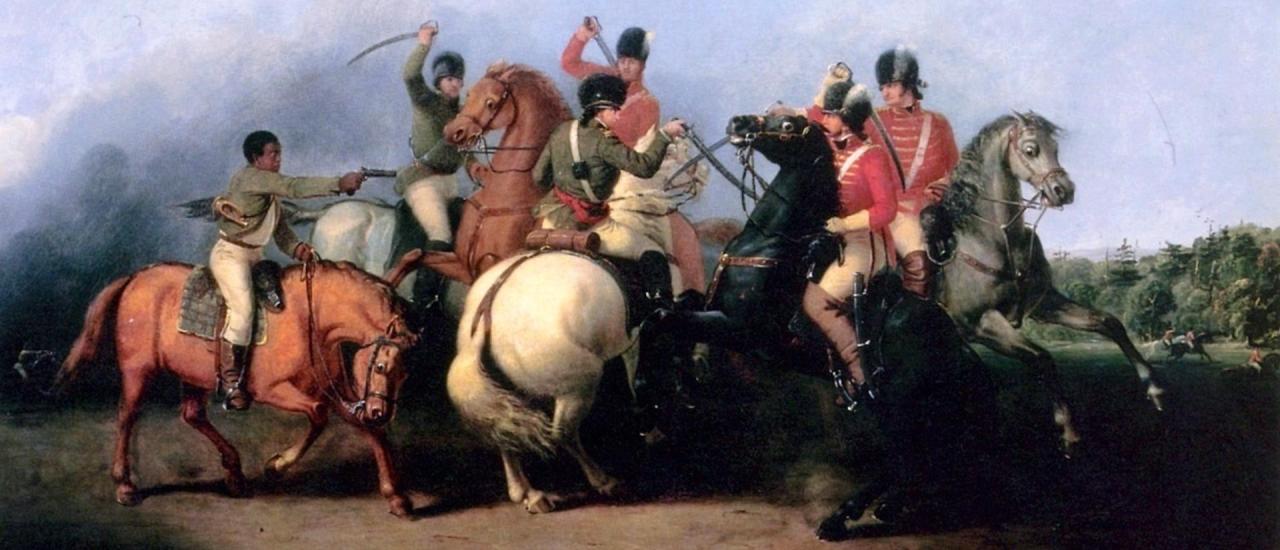
"The Battle of Cowpens" by William Ranney, 1845.
Shifting British Strategy Lesson Plan
A lesson plan for use in middle and high school classrooms.
In the wake of the Saratoga Campaign (1777) and with the following news of the French-American Alliance, the British high command in London began to reassess how they prosecuted the war in North America. It seemed as if this entire rebellion manifested itself in New England—from the Boston Tea Party to the Boston Massacre and the Battles of Lexington & Concord—New England was the hotbed of hotheads. Militarily, Crown forces attempted to suppress and then cut off the northern from their sister colonies, thus far, to no avail. A new strategy was needed if the British Empire in North America was to remain mostly intact. They looked toward the South—a rich agricultural land—and hoped the citizens were still loyal to Britain.
This Lesson Plan can be used as a prepared resource by following this curriculum plan which aligns to NCSS and Common Core Standards.
This Lesson Plan's assets can also be used on their own as supplemental resources. The display format is prepared for easy access, exploring, and learning.
The Southern Campaigns Module
Upon completion of this lesson, the students will be able to:
1. Knowledge
- Explain the British reasons for shifting military action into the Southern States
- Discuss the assumptions that the British made as they shifted into the Southern States.
2. Comprehension/Application/Analysis
- Read and research through primary source documents, then craft an argument based on the findings.
3. Evaluation
- Evaluate the changing locations of the Revolutionary War which would eventually lead to an American victory.
Check out the Lesson Plan Teaching Guide for more instructions on using the prepared Lesson Plan.
Lesson Plan Primary Source Activity:
- Use the Lesson’s PowerPoint to explore the context and history; the PowerPoint introduces Essential Questions and lays foundational knowledge about the conflict.
- Watch the “British Strategy In4” Video
- Students will examine the primary sources and build an argument to answer 1 of the following questions: British – Should we invade the Southern Colonies/States? America – Should we defend the Southern States from British invasion?
- Distribute the primary source worksheet and have the students read the provided primary sources for this lesson. Students may work on their own or as a group.
- Students may present their short argument verbally or written.
- 6 selected primary sources are available under the “Primary Source” section this lesson plan page. There are 3 British/Loyalist and 3 American sources.
OPTIONAL HOMEWORK/ASSESSMENT/ADDITIONAL ACTIVITIES:
Option 1: Charleston Virtual Field Trip
Students can watch the Charleston Virtual Field Trip, particularly the first 35 minutes which focuses on Colonial and Revolutionary history sites and culture. Students can then write a short essay about a place of interest that they saw in the video. For additional resources related to the Charleston Virtual Field Trip, including more information about featured sites, please visit this resource hub/landing page.
Option 2: Lowcountry Research
Have students choose an aspect of Lowcountry Regional geography or nature to research. Write one paragraph about their finding on the topic and one paragraph about how these findings might have helped or hindered a British invasion of the Southern States.
- Terrain
- Agricultural crops grown in the Lowcountry during 1700s
- Weather/Temperature
- Animals/Insects
- Fresh water supply
Common Core State Standards- ELA & History/Social Studies
Grades 6-8
- Key Ideas & Details:
- CCSS.ELA-LITERACY.RH.6-8.2
- Determine the central ideas or information of a primary or secondary source; provide an accurate summary of the source distinct from prior knowledge or opinions.
- CCSS.ELA-LITERACY.RH.6-8.2
- Craft and Structure:
- CCSS.ELA-LITERACY.RH.6-8.6
- Identify aspects of a text that reveal an author's point of view or purpose (e.g., loaded language, inclusion or avoidance of particular facts).
- CCSS.ELA-LITERACY.RH.6-8.6
Grades 9-10
- Key Ideas & Details:
- CCSS.ELA-LITERACY.RH.9-10.1
- Cite specific textual evidence to support analysis of primary and secondary sources, attending to such features as the date and origin of the information.
- CCSS.ELA-LITERACY.RH.9-10.2
- Determine the central ideas or information of a primary or secondary source; provide an accurate summary of how key events or ideas develop over the course of the text.
- CCSS.ELA-LITERACY.RH.9-10.1
- Craft and Structure:
- CCSS.ELA-LITERACY.RH.9-10.6
- Compare the point of view of two or more authors for how they treat the same or similar topics, including which details they include and emphasize in their respective accounts.
- CCSS.ELA-LITERACY.RH.9-10.6
- Integration of Knowledge and Ideas:
- CCSS.ELA-LITERACY.RH.9-10.8
- Assess the extent to which the reasoning and evidence in a text support the author's claims.
- CCSS.ELA-LITERACY.RH.9-10.9
- Compare and contrast treatments of the same topic in several primary and secondary sources.
- CCSS.ELA-LITERACY.RH.9-10.8
Grades 11-12
- Key Ideas & Details:
- CCSS.ELA-LITERACY.RH.11-12.2
- Determine the central ideas or information of a primary or secondary source; provide an accurate summary that makes clear the relationships among the key details and ideas.
- CCSS.ELA-LITERACY.RH.11-12.2
- Craft and Structure:
- CCSS.ELA-LITERACY.RH.11-12.6
- Evaluate authors' differing points of view on the same historical event or issue by assessing the authors' claims, reasoning, and evidence.
- CCSS.ELA-LITERACY.RH.11-12.6
- Integration of Knowledge and Ideas:
- CCSS.ELA-LITERACY.RH.11-12.8
- Evaluate an author's premises, claims, and evidence by corroborating or challenging them with other information.
- CCSS.ELA-LITERACY.RH.11-12.9
- Integrate information from diverse sources, both primary and secondary, into a coherent understanding of an idea or event, noting discrepancies among sources.
- CCSS.ELA-LITERACY.RH.11-12.8
Social Studies - National Council for the Social Studies
- Theme 2: Time, Continuity, and Change
- Theme 3: People, Places, and Environments
- Theme 5: Individuals, Groups, and Institutions
- Theme 6: Power, Authority, and Governance
- Theme 9: Global Connections
This Lesson plan
contains the following:
3 Activities | 20 Resources
Audience: Middle school | High school
This Lesson plan is a part of:
Revolutionary War Curriculum | The Southern Campaigns Module
